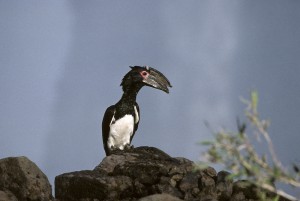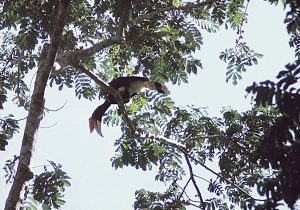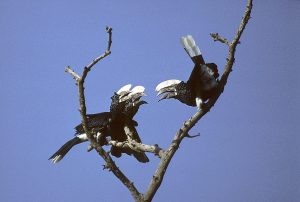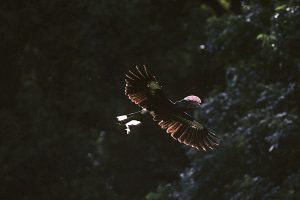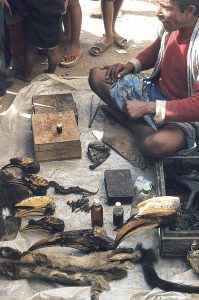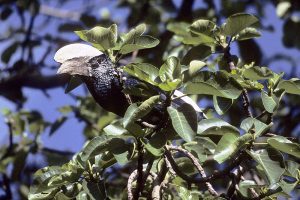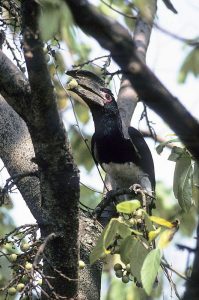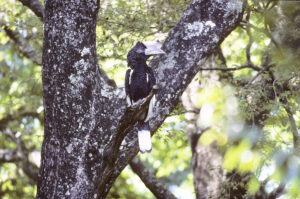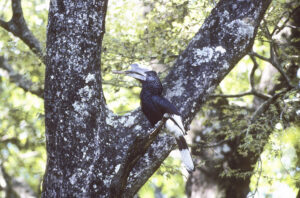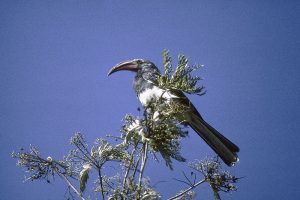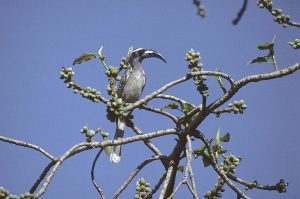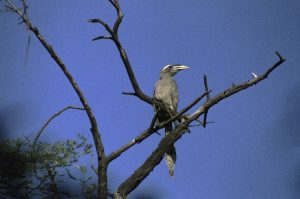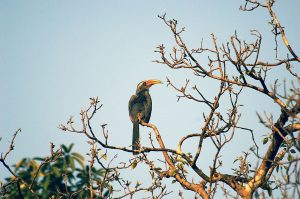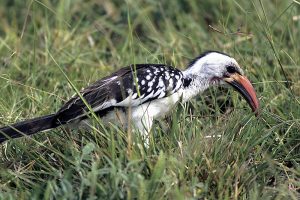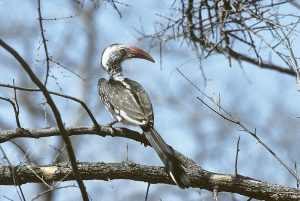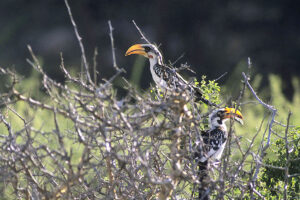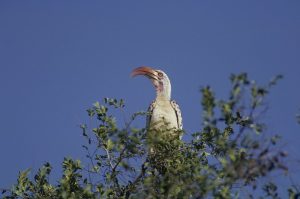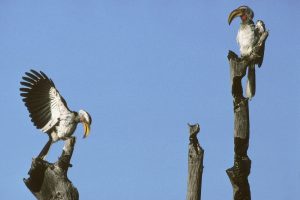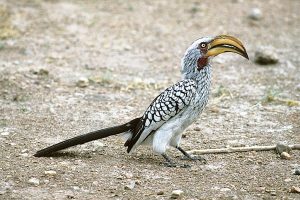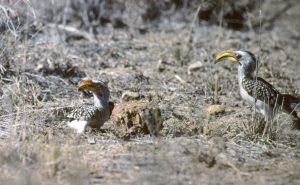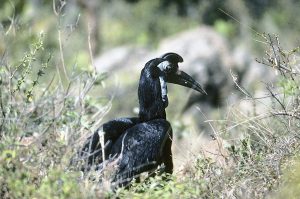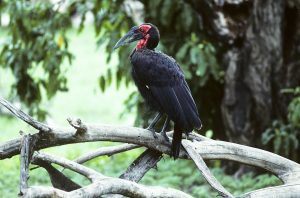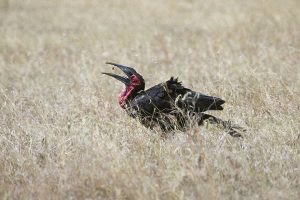Hornbills
Trumpeter hornbill (Bycanistes bucinator), sitting on a rock in front of Victoria Falls, or Mosi-oa-Tunya (’The Smoke that Thunders’), Zambezi River, Zimbabwe. (Photo copyright © by Kaj Halberg)
Hornbills are a group of peculiar birds, comprising 55-59 species, of which almost all belong to the family Bucerotidae, whereas two species, the huge ground-hornbills, have been transferred to a separate family, Bucorvidae. These birds are distributed in tropical Asia and Africa.
The name of the type genus Buceros is derived from the Greek bous (‘cow’) and keras (‘horn’), referring to a peculiar protuberance, or casque, on the bill of most species. Hornbills are very noisy, and the casque is probably a means to increase the volume of their call, which carries quite a distance.
Hornbills vary greatly in size, from the small West African black dwarf hornbill (Horizocerus hartlaubi), which is 30 cm long and weighs only c. 100 grams, to the huge rhinoceros hornbill (Buceros rhinoceros) in Malaysia and Indonesia, and the southern ground-hornbill (Bucorvus leadbeateri) in Africa, both measuring c. 1.2 m long, and the ground-hornbill weighing up to 6.2 kilos.
This rhinoceros hornbill (Buceros rhinoceros) was encountered on Sumatra. (Photo copyright © by Kaj Halberg)
Hornbills often call simultaneously, like these silvery-cheeked hornbills (Bycanistes brevis), gathered in a tree, Lake Manyara National Park, Tanzania. (Photo copyright © by Kaj Halberg)
Peculiar breeding strategy
Hornbills nest in hollow trees and are thus dependent on old growth forests. For this reason, many species have declined alarmingly during the last hundred years or so, as ever-increasing areas of tropical forests have been cleared by humans.
The breeding strategy of hornbills is very peculiar. When the female has laid her eggs inside a hollow tree, she will plaster the nest hole from inside, using her own guano which hardens in the air. Sometimes the male will help plastering the hole by bringing clay to the nest. This plaster makes it difficult for enemies like monkeys to eat eggs and young. Only a small opening is left, through which the male feeds the female during the entire incubation period. In some species, the female breaks the plaster, when the young are half grown, and then help the male feed the young – which will plaster the hole with their own guano when their mother has left! In other species, the female remains in the nest, until the young are full-grown. Meanwhile, the male brings food to all of them.
Hornbills feed mainly on various fruits, especially of fig trees (Ficus), but they also eat small animals like insects, scorpions, lizards, and snakes. When termites are swarming, hornbills often gather around termite mounds to eat the forthcoming insects.
Silvery-cheeked hornbill, catching swarming termites, Lake Manyara National Park, Tanzania. (Photo copyright © by Kaj Halberg)
Hornbills and people
Throughout their distribution area, hornbills used to play an important role in tribal mythology, and their casque and feathers were widely used as ornaments. The casque of the helmeted hornbill (Rhinoplax vigil) of Southeast Asia is very heavy. Known as ho-ting, it is much praised by the Chinese, utilized for carving. Hornbill heads are often used as an ingredient in traditional Asian medicine.
In this picture from Sarawak, Borneo, a young woman of the Punan tribe is performing a dance, with fans of hornbill feathers attached to her wrists. – My visit to this people is described on the page Travel episodes – Borneo 1975: Canoe trip with Punan tribals. (Photo copyright © by Kaj Halberg)
These street vendors in Kathmandu, Nepal, have displayed some of their goods, utilized as ingredients in traditional medicine, such as heads of hornbills and ibises, scorpions, and dried lizards. (Photos copyright © by Kaj Halberg)
In tourist areas, hornbills often become remarkably tame.
Danish biologist Thomas Bregnballe, hand-feeding a northern red-billed hornbill, Samburu National Park, Kenya. (Photo copyright © by Kaj Halberg)
Southern yellow-billed hornbills and a single southern red-billed hornbill, gathered around tourists, who are having breakfast, Kruger National Park, South Africa. (Photo copyright © by Kaj Halberg)
List of species
Below, a number of hornbill species, which I have encountered during my travels, are presented.
Family Bucerotidae
Bycanistes
A genus of 6 large species, living in forests south of the Sahara.
The generic name is a Latinized version of Ancient Greek bykanistes (‘trumpeter’), alluding to the loud call of these birds.
Bycanistes brevis Silvery-cheeked hornbill
This impressive bird is still fairly common, albeit declining, distributed from Ethiopia southwards through eastern Africa to eastern Zimbabwe and extreme north-eastern South Africa.
The specific name is Latin, meaning ‘short’. What it refers to is a bit of a mystery, as the bird is not at all short, but has a long tail. The popular name was given due to the silvery-grey dots on the side of the head and neck.
Silvery-cheeked hornbill, feeding on fig fruits, Wondo Genet, Ethiopia. (Photo copyright © by Kaj Halberg)
Bycanistes bucinator Trumpeter hornbill
This species is distributed from Kenya and eastern Zaire southwards through eastern Africa to south-eastern South Africa. It lives in various types of forest, including riverine and coastal forests.
The specific name is Latin, meaning ‘trumpeter’, from bucina (‘a military trumpet’). This bird must really be trumpeting, as the scientific name means ‘the trumpeting trumpeter’!
Trumpeter hornbill, feeding on fruits of a fig tree, Zambezi National Park, Zimbabwe. (Photo copyright © by Kaj Halberg)
Bycanistes subcylindricus Grey-cheeked hornbill
This species, also known as the black-and-white-casqued hornbill, lives in rainforests. It has a patchy distribution south of the Sahara, from Guinea eastwards to western Kenya, with an isolated population in north-eastern Angola.
The specific name is from the Latin sub (‘near to’), and cylindricus, the specific name of the brown-cheeked hornbill (B. cylindricus), thus ‘the one resembling brown-cheeked hornbill’. Cylindricus is derived from the Greek kylindros (‘cylinder’), presumably referring to the somewhat cylinder-shaped casque of these two birds.
Grey-cheeked hornbill, swallowing some large insect, Kakamega Forest, western Kenya. (Photos copyright © by Kaj Halberg)
Lophoceros
Members of this genus were formerly included in the genus Tockus (below), but have recently been moved to a separate genus. There are 7 species, all found south of the Sahara.
The generic name is derived from the Greek lophos (‘crest’) and keras (‘horn’) – an odd name, as these birds have small casques.
Lophoceros hemprichii Hemprich’s hornbill
This species is mainly an Ethiopian bird, but is also found in southern Eritrea, northern Kenya, and along the Somalian Red Sea coast. It lives in shrubland, forests, and rocky areas, often near water. The sexes are quite similar, but the female has paler red bill than the male.
This bird was named in honour of German naturalist and explorer Wilhelm Friedrich Hemprich (1796-1825), who travelled extensively in Egypt, Sudan, and Ethiopia. He died of malaria in Ethiopia, only 29 years old.
Female Hemprich’s hornbill, Yabello, southern Ethiopia. (Photo copyright © by Kaj Halberg)
Lophoceros nasutus African grey hornbill
This bird is very widely distributed south of the Sahara, from southern Mauritania and Senegal eastwards to the Red Sea coast (also on the Arabian side), and thence southwards through Ethiopia, Uganda, Kenya, and Tanzania to Mozambique and north-eastern South Africa. From here, it is found westwards to southern Angola and eastern Namibia.
It lives in open woodland and savanna. The male has a black bill, whereas that of the female is blackish, often with reddish or yellowish parts. Both sexes have a conspicuous white stripe on the upper mandible.
The specific name is Latin, meaning ‘large-nosed’, derived from nasus (‘nose’), referring to the casque, of course.
Male African grey hornbill, observed near the Blue Nile, Ethiopia. (Photo copyright © by Kaj Halberg)
Ocyceros
This genus was established in 1873 by English naturalist Allan Octavian Hume (1829-1912), encompassing 3 smaller hornbills in the Indian Subcontinent. Later, they were transferred to the genus Tockus (below), but have recently been moved back to Ocyceros.
The generic name is derived from Ancient Greek oxys (‘sharp’ or ‘pointed’) and keras (‘horn’).
Ocyceros birostris Indian grey hornbill
This bird is widely distributed, from north-eastern Pakistan (around Lahore) eastwards along the Himalaya to western Bangladesh, southwards through almost the entire Indian Peninsula. It lives from the lowlands up to an elevation of about 700 m. The male has a dark bill with a yellowish lower mandible, whereas that of the female is more yellow.
The specific name is derived from the Latin bi (‘two’) and rostrum (‘bill’), alluding to the small protuberance on top of the bill, which, with a bit of imagination, looks like an extra bill.
Female Indian grey hornbill, Keoladeo National Park, Rajasthan. (Photo copyright © by Kaj Halberg)
Ocyceros griseus Malabar grey hornbill
An Indian endemic, found along the entire West Ghats, from north of Mumbai to the southern tip of the peninsula. This species has no casque. The male has a reddish bill with a yellow tip, whereas that of the female is yellowish with black at the base of the lower mandible.
The specific name is Latin, meaning ‘grey’.
Male Malabar grey hornbill in morning light, Mahaveer Wildlife Sanctuary, Goa. (Photo copyright © by Kaj Halberg)
Tockus
A genus of 6-10 small hornbills, living in grasslands and shrubland south of the Sahara.
The generic name is derived from the French tock, applied to the African grey hornbill and the red-billed hornbill by French naturalist Georges-Louis Leclerc, Comte de Buffon (1707-1788). Supposedly, this name was based on an onomatopoeic Senegalese name of these birds.
Tockus erythrorhynchus Red-billed hornbill
Following genetic studies, some researchers claim that this bird should be split into 5 separate species, whereas other authorities still regard them as belonging to a single species. If you follow the latter, the bird is distributed from Mauritania eastwards to Eritrea and Somalia, southwards to Namibia and north-eastern South Africa.
The five species/subspecies are as follows:
The northern red-billed hornbill (T. (e.) erythrorhynchus) is found from southern Mauritania eastwards to Eritrea and Somalia, and thence southwards to Kenya and northern Tanzania.
The western red-billed hornbill (T. (e.) kempi) is distributed from southern Mauritania through Senegal and Gambia to western Mali.
The Tanzanian red-billed hornbill (T. (e.) ruahae) is restricted to central and western Tanzania.
The southern red-billed hornbill (T. (e.) rufirostris) is found from Angola and Namibia eastwards to Zambia, and thence south to north-eastern South Africa.
The Damara red-billed hornbill (T. (e.) damarensis) is restricted to southern Angola and northern and western Namibia.
The specific name is derived from the Greek erythros (‘red’) and rhynkhos (‘bill’).
Northern red-billed hornbill, subspecies erythrorhynchus, feeding in a grassy area, Tarangire National Park, Tanzania. (Photo copyright © by Kaj Halberg)
Southern red-billed hornbill, subspecies rufirostris, Matobo National Park, Zimbabwe. (Photo copyright © by Kaj Halberg)
Tockus deckeni Von der Decken’s hornbill
This species is distributed from central Ethiopia and extreme south-eastern South Sudan southwards through Somalia and Kenya to southern Tanzania. It lives mainly in arid shrublands.
It was named in honour of a German explorer, Baron Karl Klaus von der Decken (1833-1865). He was the first European attempting to climb Mount Kilimanjaro, but did not succeed due to foul weather. He also visited Madagascar and the Mascarene Islands. In 1865, he went to Somalia, exploring the lower parts of the Jubba River, on board the small steamship Welf. However, after the ship sank in rapids, he and three others in his party were murdered by hostile Somalis.
Female von der Decken’s hornbill, Awash National Park, Ethiopia. The female has a dark bill, whereas the male has a red bill with an ivory-coloured tip. (Photos copyright © by Kaj Halberg)
Tockus flavirostris Eastern yellow-billed hornbill
This bird, also known as northern yellow-billed hornbill, is similar to southern yellow-billed hornbill (below), but has blackish skin around the eyes. It is found in eastern Africa, from Eritrea, Djibouti, and Somalia southwards to extreme south-eastern South Sudan, eastern Uganda, Kenya, and extreme northern Tanzania.
The specific name is derived from the Latin flavus (‘yellow’) and rostrum (‘bill’).
Eastern yellow-billed hornbills, Samburu National Park, Kenya. (Photo copyright © by Kaj Halberg)
Tockus jacksoni Jackson’s hornbill
This bird resembles von der Decken’s hornbill (above), but has dense white spots on the wing-coverts. It is restricted to a rather small area in south-eastern South Sudan, south-western Ethiopia, north-eastern Uganda, and north-western Kenya. The population is decreasing.
The name of this species was given in honour of Sir Frederick John Jackson (1860-1929), an English administrator, explorer, and ornithologist, who lived in Kenya.
Male Jackson’s hornbill, Lake Baringo, Kenya. This individual has a very pale head. Usually, males have a dark smudge around the eye. (Photo copyright © by Kaj Halberg)
Tockus leucomelas Southern yellow-billed hornbill
This species is distributed from Angola and Namibia eastwards across Botswana and northern South Africa to extreme southern Zambia and Mozambique. It is similar to eastern yellow-billed hornbill (above), but has pinkish skin around the eye and beneath the bill.
The specific name is derived from Ancient Greek leukos (‘white’) and melas (‘black’), thus ‘black and white’.
A pair of southern yellow-billed hornbills, greeting each other in the morning sun, Matobo National Park, Zimbabwe. (Photo copyright © by Kaj Halberg)
Southern yellow-billed hornbill, photographed on a campground in Etosha National Park, Namibia. – This park and other fantastic natural areas in Namibia are presented on the page Countries and places: Namibia – a desert country. (Photo copyright © by Kaj Halberg)
Southern yellow-billed hornbills, feeding on insects in elephant dung, Kruger National Park, South Africa. (Photo copyright © by Kaj Halberg)
Family Bucorvidae Ground-hornbills
The huge ground-hornbills may grow to about 1.2 m long and weigh up to 6.2 kg. They differ sufficiently from true hornbills (above) to form a separate family, containing only 2 species in the genus Bucorvus.
Their habitat is grasslands with short vegetation and scattered trees, in which they nest. They differ mainly in their feeding habit, as they spend most of their time on the ground, searching for prey like lizards, snakes, and larger insects.
Bucorvus
The generic name is composed of two other genus names, Buceros (see above), and Corvus (ravens and crows), thus ‘the hornbills that resemble crows’.
Bucorvus abyssinicus Abyssinian ground-hornbill
This species, also known as northern ground-hornbill, is endemic to Ethiopia (in former times called Abyssinia). It differs from the southern species (below) by its blue wattles and a larger casque. It is declining due to habitat destruction and hunting.
Abyssinian ground-hornbill, photographed near the Genale River, Ethiopia. (Photo copyright © by Kaj Halberg)
Bucorvus leadbeateri Southern ground-hornbill
This bird is found from Rwanda, Kenya, south-eastern Zaire, and Angola southwards to northern Namibia, northern Botswana, and eastern South Africa. It has been declining in later years.
The specific name refers to Benjamin Leadbeater (1760-1837), an English natural history dealer in London.
Southern ground-hornbill, Lake Manyara National Park, Tanzania. (Photo copyright © by Kaj Halberg)
This southern ground-hornbill, observed in Serengeti National Park, Tanzania, is swallowing a beetle or some other insect. (Photo copyright © by Kaj Halberg)
(Uploaded February 2016)
(Latest update August 2023)
